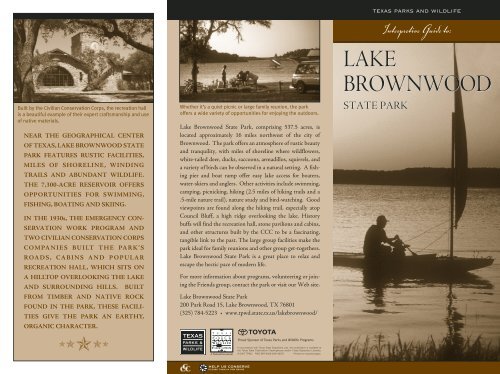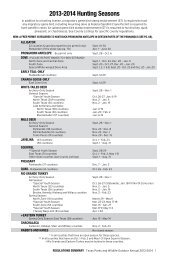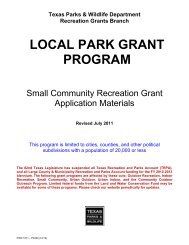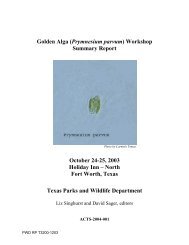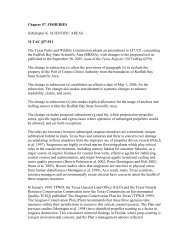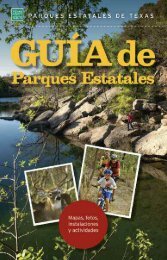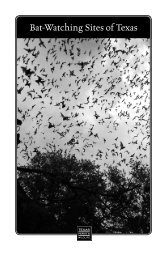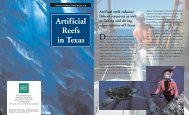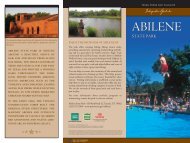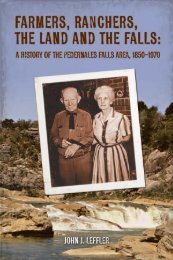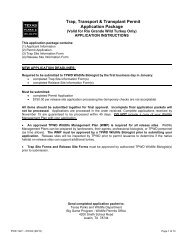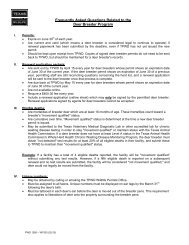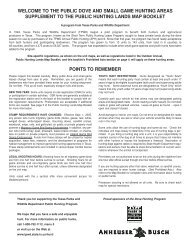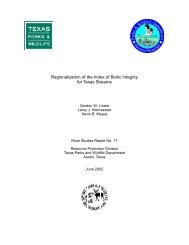Lake Brownwood State Park Interpretive Guide - Texas Parks ...
Lake Brownwood State Park Interpretive Guide - Texas Parks ...
Lake Brownwood State Park Interpretive Guide - Texas Parks ...
Create successful ePaper yourself
Turn your PDF publications into a flip-book with our unique Google optimized e-Paper software.
Built by the Civilian Conservation Corps, the recreation hall<br />
is a beautiful example of their expert craftsmanship and use<br />
of native materials.<br />
NEAR THE GEOGRAPHICAL CENTER<br />
OF TEXAS, LAKE BROWNWOOD STATE<br />
PARK FEATURES RUSTIC FACILITIES,<br />
MILES OF SHORELINE, WINDING<br />
TRAILS AND ABUNDANT WILDLIFE.<br />
THE 7,300-ACRE RESERVOIR OFFERS<br />
OPPORTUNITIES FOR SWIMMING,<br />
FISHING, BOATING AND SKIING.<br />
IN THE 1930s, THE EMERGENCY CON-<br />
SERVATION WORK PROGRAM AND<br />
TWO CIVILIAN CONSERVATION CORPS<br />
COMPANIES BUILT THE PARK’S<br />
ROADS, CABINS AND POPULAR<br />
RECREATION HALL, WHICH SITS ON<br />
A HILLTOP OVERLOOKING THE LAKE<br />
AND SURROUNDING HILLS. BUILT<br />
FROM TIMBER AND NATIVE ROCK<br />
FOUND IN THE PARK, THESE FACILI-<br />
TIES GIVE THE PARK AN EARTHY,<br />
ORGANIC CHARACTER.<br />
✯✯ ✯ ✯✯<br />
Whether it’s a quiet picnic or large family reunion, the park<br />
offers a wide variety of opportunities for enjoying the outdoors.<br />
<strong>Lake</strong> <strong>Brownwood</strong> <strong>State</strong> <strong>Park</strong>, comprising 537.5 acres, is<br />
located approximately 16 miles northwest of the city of<br />
<strong>Brownwood</strong>. The park offers an atmosphere of rustic beauty<br />
and tranquility, with miles of shoreline where wildflowers,<br />
white-tailed deer, ducks, raccoons, armadillos, squirrels, and<br />
a variety of birds can be observed in a natural setting. A fishing<br />
pier and boat ramp offer easy lake access for boaters,<br />
water-skiers and anglers. Other activities include swimming,<br />
camping, picnicking, hiking (2.5 miles of hiking trails and a<br />
.5-mile nature trail), nature study and bird-watching. Good<br />
viewpoints are found along the hiking trail, especially atop<br />
Council Bluff, a high ridge overlooking the lake. History<br />
buffs will find the recreation hall, stone pavilions and cabins,<br />
and other structures built by the CCC to be a fascinating,<br />
tangible link to the past. The large group facilities make the<br />
park ideal for family reunions and other group get-togethers.<br />
<strong>Lake</strong> <strong>Brownwood</strong> <strong>State</strong> <strong>Park</strong> is a great place to relax and<br />
escape the hectic pace of modern life.<br />
For more information about programs, volunteering or joining<br />
the Friends group, contact the park or visit our Web site.<br />
<strong>Lake</strong> <strong>Brownwood</strong> <strong>State</strong> <strong>Park</strong><br />
200 <strong>Park</strong> Road 15, <strong>Lake</strong> <strong>Brownwood</strong>, TX 76801<br />
(325) 784-5223 • www.tpwd.state.tx.us/lakebrownwood/<br />
Proud Sponsor of <strong>Texas</strong> <strong>Park</strong>s and Wildlife Programs<br />
In accordance with <strong>Texas</strong> <strong>State</strong> Depository Law, this publication is available at<br />
the <strong>Texas</strong> <strong>State</strong> Publications Clearinghouse and/or <strong>Texas</strong> Depository Libraries.<br />
© 2007 TPWD. PWD BR P4506-009H (6/07) Printed on recycled paper.<br />
texas parks and wildlife<br />
<strong>Interpretive</strong> <strong>Guide</strong> to:<br />
LAKE<br />
BROWNWOOD<br />
STATE PARK
L A K E B R O W N W O O D S T A T E P A R K<br />
NATURAL BEAUTY<br />
The park lies in an area of mixed habitats. The plants and<br />
animals of this area are a combination of species from the<br />
Edwards Plateau and Grand Prairie to the south and east,<br />
the Western Cross Timbers to the north, and the Rolling<br />
Plains to the west. Typical vegetation for the Edwards<br />
Plateau is grassland with live oak on level to gently rolling<br />
terrain, but slopes and stream bottoms are generally<br />
wooded or brushy. The Western Cross Timbers usually<br />
supports woodlands of dwarfed post oak and blackjack oak.<br />
The Rolling Plains supports grasslands with shrubby vegetation<br />
growing on the rougher sites; woody plants usually<br />
grow along river bottoms. These three vegetation regions<br />
of <strong>Texas</strong> overlap around <strong>Lake</strong> <strong>Brownwood</strong>, making the<br />
park an excellent place to study the area’s natural diversity.<br />
Though used by many Native American cultures long<br />
before Europeans arrived, the land in Brown County was<br />
first associated in eighteenth-century Spanish colonial histories<br />
with the Lipan, or eastern, Apaches. By the middle<br />
of the 1700s, the Comanche had mastered the horse and<br />
were quickly amassing a territory where they hunted and<br />
camped in a nomadic fashion. Captain Randolph B. Marcy<br />
of the U.S. Army, who led a patrol in the area in 1851,<br />
reported that Pecan Bayou was a favorite of the tribe. The<br />
Comanche and earlier Native American groups were<br />
drawn to this area by water and abundant game.<br />
Captain Henry S. Brown, a <strong>Texas</strong> Revolutionary soldier,<br />
was the first white man known to traverse the area. In<br />
1828, Brown, with about 25 men and a Native American<br />
guide, trailed a Comanche raiding party into what is now<br />
Brown County. Other settlers soon followed and began farming<br />
the floodplains and ranching the hill country. The county<br />
was organized in 1857 and named for Captain Brown.<br />
DEVASTATION CONTROLLED<br />
After a devastating flood in 1900, Brown County residents,<br />
and especially citizens of <strong>Brownwood</strong>, became interested in<br />
ways to control the periodic surges of Pecan Bayou and its<br />
tributary, Jim Ned Creek. They also needed to regulate the<br />
availability of water for domestic, agricultural and ranching<br />
use. This effort became increasingly critical as the population<br />
of the county and <strong>Brownwood</strong> grew. Results of a 1926 election<br />
showed overwhelming support for the organization of<br />
the Brown County Water Improvement District and the<br />
construction of a dam.<br />
Beginning in 1926, the Brown County Water Improvement<br />
District acquired seven tracts of land for the purpose of<br />
damming and impounding the waters of Pecan Bayou at its<br />
confluence with Jim Ned Creek. Construction commenced,<br />
and the dam was completed in early 1932. Skeptics predicted<br />
it would be years before the lake would fill with water. In July<br />
of the same year, a record-breaking flood swept down Pecan<br />
Bayou, and the lake filled to a level covering more than 7,000<br />
acres practically overnight. Since that time, the reservoir has<br />
provided a constant supply of drinking water and irrigation<br />
water, tamed the uneven and sometimes destructive flow of<br />
Pecan Bayou, and provided recreational opportunities. In 1933,<br />
the <strong>Texas</strong> <strong>State</strong> <strong>Park</strong>s Board acquired the park’s 538 acres by<br />
deed from the Brown County Water Improvement District<br />
for the purpose of establishing a state park on the lake.<br />
A RICH HISTORY<br />
Construction on the park<br />
began in 1933, after approval<br />
of county and state applications<br />
for relief work programs under Civil Works Administration<br />
(CWA) authority. The CWA employed local men<br />
who were part of Emergency Conservation Work programs,<br />
the forerunner of the Civilian Conservation Corps (CCC).<br />
Part of Franklin D. Roosevelt’s New Deal recovery program<br />
for a Depression-wracked nation, CCC work camps<br />
established across the country in the 1930s offered work to<br />
unemployed young men and improvements to state lands.<br />
Lobbying efforts by county and state officials resulted in a<br />
CCC company at <strong>Lake</strong> <strong>Brownwood</strong> in November 1934.<br />
Company 872 arrived at <strong>Lake</strong> <strong>Brownwood</strong> from Tecumseh,<br />
Oklahoma, and continued the unfinished construction<br />
begun under the CWA and started work on additional<br />
park facilities. In November 1935, Company 872 was transferred<br />
after their one-year assignment, and the camp was<br />
abandoned. A second CCC unit arrived in October 1936.<br />
Company 849 continued the work at the park and remained<br />
there until February 1942, when the camp was closed.<br />
The locally quarried rock used on the outdoor patios and<br />
stairs gives the park a timeless feel. Fire pits, curved<br />
benches, culverts and picnic tables, designed by the<br />
National <strong>Park</strong> Service and built by the CCC, are scattered<br />
throughout the park. The recreation hall sits on top of a<br />
hill, and its rooftop observation deck gives a good view of<br />
the park, lake and surrounding rolling hills. By the time<br />
they left, the CCC men had completed 17 cabins and<br />
nearly 100 other structures.<br />
During World War II, the park served as a rest-and-recreation<br />
site for soldiers stationed at Camp Bowie. After the<br />
war, Texans returned to the park to take advantage of its<br />
vast recreational opportunities.


